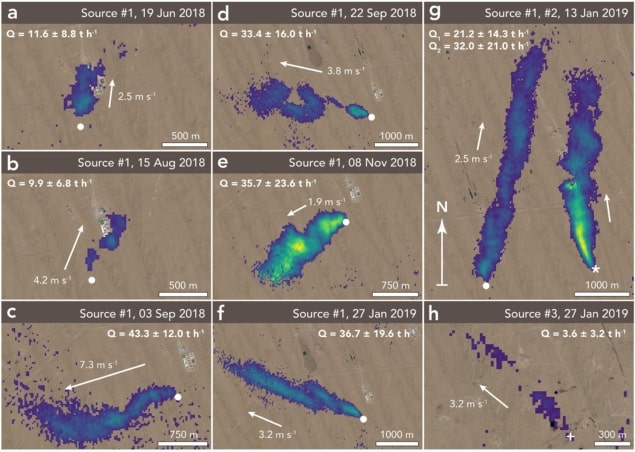
The satellite was supposed to be looking for mud volcanoes.
Instead, it found an ongoing environmental hazard.
That, in essence, is the story Adina Gillespie told attendees at the Appleton Space Conference, which was held last week at the UK’s Rutherford Appleton Laboratory (RAL). Gillespie is the business development manager at GHGSat, a Montreal, Canada-based start-up that made headlines in November thanks to its methane-sniffing microsatellite. The satellite – dubbed “Claire” after the daughter of a GHGSat employee – has been operating since 2016 as testbed for space-based monitoring of methane, a potent greenhouse gas. Although GHGSat is mainly interested in methane emissions from human activities such as oil and gas production, when an academic geoscientist asked if it could also look for methane-belching mud volcanoes in Central Asia, it agreed to try.
In January 2019, the GHGSat team notched up an apparent success, detecting a plume of methane in western Turkmenistan. But something was wrong. The plume was far too big to be coming from a mud volcano. In fact, the GHGSat scientists and their collaborators calculated that, over the course of a year, the Turkmenistan site released between 108 and 176 metric kilotons of methane – equivalent to the annual output of one million cars.
“This isn’t a situation where you can just call up the operator and say, ‘Hey, you have a problem,’” Gillespie told the audience. Instead, she explained, GHGSat contacted the methane emitter indirectly, via diplomatic channels. Eventually, their intervention had the desired effect: images taken later in 2019 showed a substantial decrease in the site’s methane emissions.
Gillespie declined to name the party responsible for emitting so much methane, explaining that, in GHGSat’s view, “the opportunity for impact comes from working collaboratively, not from policing”. In general, though, she says she is “pushing at an open door” when she talks to oil and gas executives about using space-based monitoring to spot methane leaks. Executive bonus pay at several companies – including Shell, Chevron and the mining firm BHP – is now tied to mitigating greenhouse gas emissions, and Gillespie thinks that campaigns to divest in heavily-emitting firms are also having an impact. Besides, the methane itself has a value. “Their assets are leaking,” she says. “They have an incentive to do something about it.”
Gillespie’s talk was one of 18 during the conference, which brought together astronomers, space scientists and geoscientists from the UK and beyond for a day of lectures and networking. Other highlights included a talk about space ice from the Open University astrochemist Helen Fraser; a description of ESA’s planned Comet Interceptor mission from Geraint Jones, a planetary scientist at University College London; and a presentation by Shefali Sharma of Oxford Space Systems on new ways of deploying lightweight structures such as shields, booms and frames in space.
During one of the breaks, I caught up with Richard Harrison, the chief scientist at RAL Space, which hosted the conference. Like several other speakers at the event, Harrison was bound by rules that prohibit UK officials from making any comment on government policy during the run-up to a general election. He was, however, happy to chat about the relatively non-political topic of solar observation.
In Harrison’s view, the next few years will be exciting ones for the solar-science community. NASA’s Parker Solar Probe is already returning data from a recent solar encounter, while a major ESA mission, Solar Orbiter, is due to launch in February 2020 – more than 20 years after it was first proposed. “To see that go up would be fantastic,” he says.
Looking further in the future, Harrison is particularly excited about a not-yet-funded ESA spacecraft called Lagrange, which would act as a pathfinder to a 24/7 monitoring service for space weather. While earlier missions such as SOHO, Hinode, STEREO and the Solar Dynamics Observatory have taught physicists a great deal about solar activity, Harrison explains that their data can only explain space-weather events after the fact. Lagrange, however, could sound the alert about potentially damaging space weather as soon as it happened, giving experts anywhere from 36 hours to several days to mitigate the effects on satellites and power grids. “We’re into a different domain,” he says.
In some ways, GHGSat’s methane-sniffing satellite and Lagrange’s space-weather observatory could hardly be more different. The first was launched cheaply and quickly by a private company; the second will be a multi-year and multi-national effort led by academic and government scientists. What they have in common, though, is that they are using space technologies to protect and preserve the planet and the fragile, fractious humans who live on it. On a dark and murky day in December, that seems like a reason to be cheerful.
- This article was modified on 11 December 2019 to correct Richard Harrison’s job title and clarify who organized the conference.



